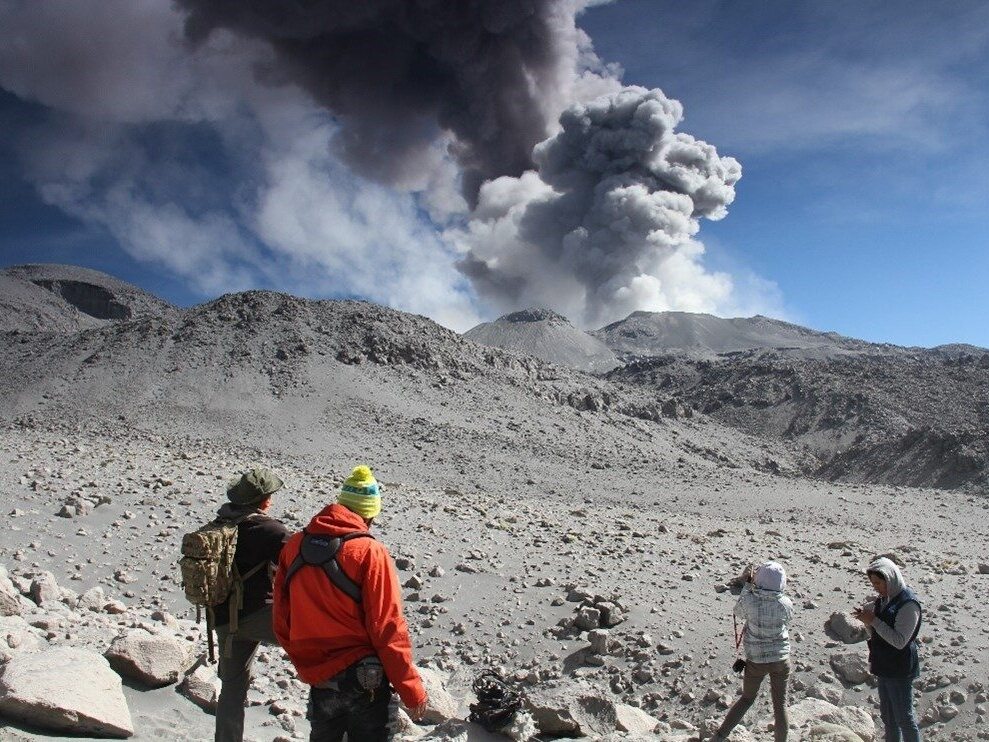The lunar landscape of the Valley of Volcanoes. Are Polish researchers playing with fire?

Volcanoes have always attracted people’s attention. And when they sometimes slumbered longer, their awakening brought death and destruction to the inhabitants. Dr. Andrzej Gałas (IGSMiE, PAN), who conducts research on a group of volcanoes in southern Peru, told “Wprost” what he has been working on for years.
Around 1500 BC, the eruption of the Santorini volcano (Greece) ended the bright days of the Minoan civilization, Vesuvius in 79 AD covered the rich and sumptuous city of the Roman Empire with ashes. In 2010, the eruption of a little-known volcano in Iceland (Eyjafjallajökull) grounded planes across Europe for several days. Are there still unexplored volcanoes in the world whose eruption can be as surprising? Dr. Andrzej Gałas (IGSMiE, PAN) is one of the volcanologists who study remote volcanoes in the Peruvian Andes.
The first photos from the Valley of Volcanoes hidden in the Andes hit the pages of National Geographic in 1936. Photos were taken by Sheepe and Johnson. “Inhabitants of Arequipa say that when the Moon separated from the Earth, it forgot to take with it the vicinity of this Peruvian city. However, if the lunar surface looked like the Peruvian land of canyons and volcanoes, the crew from Apollo 11 would have much more difficulty navigating the Silver Globe” – this is how Olgierd Budrewicz wrote about the region years ago in “Wprost”, reporting on the return of a group of Poles to Colca. The discovery of the Colca Canyon in 1981 and the crossing of the river’s current by students from the “Bystrze” club at the AGH University of Science and Technology in Krakow provoked the work of the Polish Scientific Expedition to Peru (PWNP).
What are volcanoes and how are they formed?
In order to understand what scientists are doing as part of the Polish Scientific Expedition to Peru, we need to refer to the definition of a volcano – a place from which magma was coming to the surface of the Earth. In the simplest terms, a volcano is a mountain formed from the products of an eruption (lava and ash) around a volcanic vent, and its structure will depend on many factors, including the strength and frequency of activity (eruption).
– The volcano, formed as a result of a series of low-power eruptions that result in a pyroclastic cone about 100 meters high, will have a relatively simple (monogenetic) structure. A volcano such as Etna, known in Europe, will look completely different, the height of which is over 3,000 meters and, in addition to the main peak, has about 200 parasitic cones on its slopes. Etna has a long history of activity and a complex (polygenetic) structure – says “Wprost” Dr. Eng. Andrzej Gałas, volcanologist and technical manager of the Polish Scientific Expedition to Peru (PWNP), currently working at the Institute of Mineral Resources and Energy Management, Polish Academy of Sciences in Krakow.
So if we have information about how volcanoes form, the question of where and why is relevant becomes relevant. All thanks to the construction of our planet. Volcanic activity is present in zones of rift (fracture) and subduction (push) of the earth’s crust and in hot spots.
“Our planet is a bit like a conveyor belt. The plates of the earth’s crust, torn apart and pushed apart in one place (rift), move and sometimes there is a collision between them. This is how the Himalayas were created. Sometimes one plate slides under another and this process is called subduction. Of course, in the rift zone, magma often pushes between the plates and rises to the surface, resulting in the formation of chains of volcanoes, including undersea volcanoes. In the subduction zone, the oceanic plate dips below the continental plate and sinks down to the hot zones of the Earth’s mantle. The rapid melting of the crustal rocks, which also contain water, causes streams of energy to rise from the Earth’s mantle to the surface. As a result, volcanic ridges are formed, such as the Andes in South America, explains the expert.
In turn, hot spots or hot spots are places where a stream of heat from the Earth’s mantle enters its surface. As a result, a volcano often forms in this place. If a plate of oceanic crust moves over such a point, rows of islands form. – This structure of our planet causes that volcanoes in various parts of the globe are constantly active. In the period of January 11-17, 2023, 20 volcanoes were active, including Anak Krakatau known to every volcanologist from the eruption in 1883, which caused the death of 36,000 people. people and cooling the climate on Earth for 2-3 years – says the volcanologist.
Forecasting activity helps to avoid tragedies
Another issue is volcanic activity. Our expert explains that knowledge of the history of the volcano plays a key role in predicting the threat. If we already know that it is dangerous and there are inhabitants who are threatened, research stations are built (terrestrial or satellite observations). They are equipped with instruments tracking the intensity of phenomena: tremors, temperature increase, land deformations, gas emissions, geochemistry (changes in the chemical composition of waters).
– If the intensity of these phenomena increases, the threat level increases and further alert levels are announced. In this way, the movement of magma towards the surface is also tracked (seismic, gravimetry). The accuracy of forecasts is constantly improving, provided these monitoring networks are in place. Of course, volcanoes are a threat. There are large cities that are located extremely close to infamous volcanoes. E.g. Quito, Arequipa, Naples. Vesuvius is in the vicinity of Naples, but volcanologists are more afraid of the Campi Flegrei volcano (Place Flegrei), which is located on the other side of the city on the Gulf of Naples. Ashes from its eruption 40,000 years ago years ago, found near Moscow. Active fumaroles, fluctuations of the bottom level in the bay and on the shore, confirm the presence and activity of the hot magma reservoir. Many say that it is the most dangerous volcano in Europe – said Dr. Eng. Andrzej Galas.
In turn, the La Palma volcano (Canary Islands) was active in the period from September 19 to December 13, 2021. During the eruption, 6 craters were formed, the highest cone was 175 meters high and ejected 200 million m3 lava. Its temperature was 1140 ° C and completely destroyed the houses of two villages, infrastructure and farmland. – Fortunately, the eruption was monitored and the inhabitants were evacuated earlier. We can imagine what will happen when there is a city of many millions with dense buildings in the vicinity of the volcano – says the expert.
From the discovery of the Colca Canyon to the creation of the UNESCO Geopark
Climbing Colca Canyon by kayaking was likened to climbing Mount Everest. This was achieved in 1981 by Poles: expedition leader Andrzej Piętowski, canoeist Piotr Chmieliński, dinghy captain Jerzy Majcherczyk, crew members Stefan Danielski and Krzysztof Kraśniewski, filmmaker Jacek Bogucki and photographer Zbigniew Bzdak. The achievements of the Canoandes ’79 kayak expedition were entered in the Guinness Book of Records in 1984. The efforts of the participants of the Polish Scientific Expedition to Peru were also aimed at protecting this place. As a result, a UNESCO Geopark was established there.
The history of research by scientists from AGH dates back to 2003, when a reconnaissance trip of employees of the Faculty of Geology, Geophysics and Environmental Protection, prof. Andrzej Paulo and Dr. Andrzej Gałaś to the Valley of the Volcanoes. The main advantage of these regions is the clear geological structure, giving the opportunity to observe the processes taking place there: the effects of earthquakes, faults, erosion, mass movements and various forms of young volcanic activity.
– The Valley of the Volcanoes, where the most beautiful pyroclastic cones of the Andahua group occur, has been included in the UNESCO Colca and Andagua Volcanoes Geopark since 2019. By a strange coincidence in the Valley, there is also an area called Pampa Huajana, which in Qechua means “Pampa where children cry”. This is important information for ensuring the safety of numerous tourists coming to the geopark, which is the subject of my cooperation with Peruvian scientists from the Volcanological Observatory in Arequipa (INGEMMET, Peru) – says the volcanologist.
Volcanic activity in the Colca region
Dr. Eng. Andrzej Gałas leads a project of a group of volcanoes in southern Peru. The last of them was active about 350 years ago. These are mainly small lava domes and pyroclastic cones scattered in a difficult mountainous terrain. As he says, when he started his research, they were not even marked out in the field and counted, so he spent the first years doing cartographic work to determine the extent of occurrence and the number of eruption centers.
– There are currently no active volcanoes in Poland. That is why my research ground since 2003 has been the volcanoes of the Andahua group located in the southern Andes. PWNP is tasked with documenting the environmental values of the Colca Canyon and the Valley of Volcanoes. My project fits perfectly into this goal. Volcanoes are an interesting research object, and additionally they are a great tourist attraction. The hard-to-reach terrain made these volcanoes unexplored for a long time. Compared to stratovolcanoes, they are small in size and hidden in the mountains do not pose a great threat to a small population of inhabitants – says Dr. Eng. Gall.
The discovery of the Poles changed the view on the threat
Let us remind you that when he started the project, even their number and range of products (lava, ashes) were not known. After years of work, he managed to find more than 146 eruption centers: 43 pyroclastic cones and 103 lava domes. Works were carried out in the area of 10 thousand. km2, in the height range from 1,130 to 5,700 m above sea level – Few researchers paid attention only to pyroclastic cones, which are easy to distinguish in the field. The volcanoes of this group were described as monogenetic, with a simple structure. Meanwhile, my research led to the fact that today the Andahua group is defined as dominated by lava flows. I also proved that, apart from simple cones, there are also complex volcanoes. The world-famous volcanologist prof. Károly Németh from Massey University in New Zealand, whose experience I used in editing the final applications – says “Wprost”.
In 2017, the volcanologist led the expedition, in which participated: Dr. Paulina Lewińska (Faculty of Geodesy and Mining Engineering, AGH) and four students (Faculty of Geology, Geophysics and Environmental Protection, AGH). In the lavas, they managed to find rare minerals – garnets. “This is the first unique occurrence of these minerals in modern lavas in the Andes. Moreover, the inclusions contained in garnet crystals contain sulfur. A well-known grenade specialist, prof. Jarek Majka (Uppsala University and AGH) stated that they were formed during the contact of magma with rocks rich in sulphates. This changes the view on the threat that the volcanoes of the Andahua group could pose if they awaken. The eruption may be accompanied by a much larger amount of sulfur compounds in the air. Also in concentrations harmful to humans and other living organisms. These types of small volcanoes, when they are active, are often visited by tourists (e.g. in Iceland) – adds Andrzej Gałas.
There is a need for further research
The work is carried out as part of the Polish Scientific Expedition to Peru, a group of scientists from various centers (University of Silesia, Jagiellonian University) without a permanent source of funding.
There has been a certain regionalism in volcanology for many years. Volcanic areas attract scientists, research centers and volcanological observatories are created. Their task is to further develop methods of forecasting and describing the processes that occur inside the Earth and are responsible for volcanic eruptions. It is very difficult to find a research object that is outside the scope of interest of such centers. The more so that volcanoes have an “explosive character” and freely announce their existence with rain of ashes, fireworks, tsunami waves, etc.
Investigated by Dr. Andrzej Gałaś, a group of volcanoes in southern Peru still holds many secrets. Are the settlements abandoned hundreds of years ago the result of clouds containing hydrogen sulfide and sulfuric acid? What is the connection with the existence of so many small volcanoes along the deepest canyon in the world? Can the thermal waters flowing at the foot of the lavas be used as a source of energy and raw materials? We are waiting for further analyses, maybe soon we will be able to answer these and other questions. Interested parties can obtain up-to-date information on the project’s home page.






